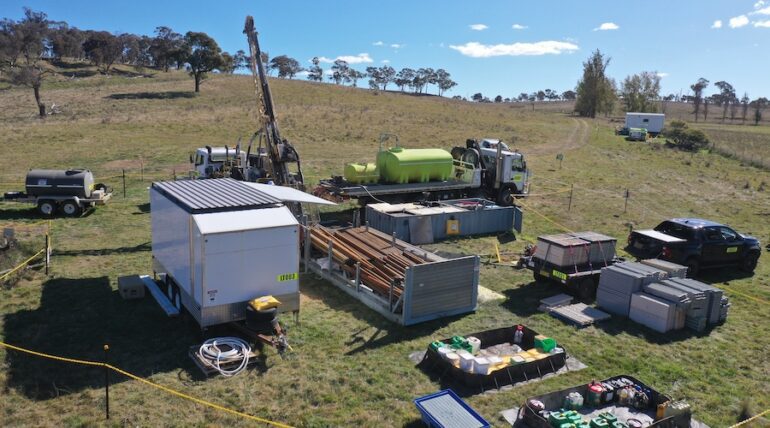TL;DR:
- Earth AI employs artificial intelligence to discover high-grade molybdenum in a previously barren region near Armidale, Australia.
- Their success rate of one in eight is a significant improvement over the industry standard of one in 200 for finding economic-grade mineralization.
- Earth AI’s Mineral Targeting Platform, trained on extensive geological data, played a pivotal role in pinpointing the valuable deposits.
- Modular drilling, responsible and efficient, contributed to their success by minimizing environmental impact and ensuring operational efficiency.
- The AI system operates in three phases: Targeting, Hypothesis, and Drilling, making it one of the most accurate in the industry.
- Earth AI’s AI system is unique as it combines geological expertise with AI mastery, re-learning archive data at a continental scale and predicting mineral systems with low detection limits.
Main AI News:
In the world of clean energy metals exploration, Earth AI is making headlines with its groundbreaking discovery of a greenfield molybdenum deposit, all thanks to the power of artificial intelligence. Located near Armidale, New South Wales, Australia, this unassuming piece of land, once believed to be barren, has now unveiled its hidden riches.
Roman Teslyuk, the visionary founder and CEO of Earth AI, along with his dedicated team, embarked on an extraordinary journey of scientific exploration. They began by formulating a series of hypotheses and systematically testing them through the drilling of strategic holes. These rigorous efforts persisted for eight months, with four holes meticulously bored into the high Australian plateau amidst challenging winter conditions and equipment losses due to snow.
The results were nothing short of extraordinary. Teslyuk proudly shared, “Prior to this, we drilled four holes in the Northern Territory. This brings us to a one-in-eight success rate at discovering economic-grade mineralization, which is a remarkable improvement over the industry standard of one in 200,” in an exclusive interview with Mining.com.
But how did Earth AI manage to turn what seemed like an arid wasteland into a mineral-rich treasure trove? Their secret weapon is the Mineral Targeting Platform, a geological deep learning solution renowned for its ability to analyze surrounding geological and geophysical data to identify mineral systems. This platform has been meticulously trained on a vast database of known mineral prospects across the continent, enabling it to predict new systems.
In this particular case, Earth AI set its sights on land that had previously stumped junior explorers and major mining companies who had invested substantial sums in exploration efforts with no success. Undeterred, Earth AI obtained licenses, consulted with the local community, secured all necessary permits, and embarked on a determined exploration journey, ultimately discovering high-grade molybdenum with grades exceeding those found in the world’s leading molybdenum mines.
But Earth AI doesn’t limit its exploration to a single metal. Their expertise lies in studying entire mineral systems to identify the metals likely to form an economic deposit. This holistic approach also leads them to indirectly track other critical metals, such as copper, tin, tungsten, and gold, which may either form adjacent deposits or serve as secondary commodities. In this particular discovery, Earth AI even intersected low-grade copper adjacent to the high-grade molybdenum mineralization, further highlighting the diversity of their findings.
One of the key innovations that set Earth AI apart is its use of modular drilling, also known as responsible drilling. This approach emphasizes modularity for redundancy and operational efficiency, making it a sustainable choice for mineral exploration. Earth AI’s modular hardware eliminates the need for groundwork, and its onboard waste management system ensures the safe disposal of drilling waste. This method also streamlines logistics, allowing for better preparation and self-sufficiency in the face of various drilling challenges.
Now, let’s delve into the heart of Earth AI’s success—the AI system itself. This intelligent technology is the cornerstone of their exploration process, comprising three phases: Targeting, Hypothesis, and Drilling. During the Targeting phase, Earth AI’s AI system, trained on millions of geological cases from across the continent, identifies areas of mineralization with a high probability of hosting a mineralized system. This targeted information guides field teams in sampling and evaluating potential sites.
In the Hypothesis phase, geologists work closely with a sister technology that aids in understanding the geological context and forming hypotheses. These hypotheses are then put to the test in the Drilling phase, where Earth AI drills down to depths of 600 meters to confirm or negate the presence of mineralization. The knowledge gained from each drill hole is continuously fed back into the AI system, enhancing its predictive accuracy, making it one of the most reliable tools in the industry.
But what fuels this impressive AI system? Earth AI’s AI is trained on a vast dataset comprising 400 million geological cases from across the continent, with fundamental datasets including remote sensing, geophysical, and geochemical data.
What truly sets Earth AI’s AI system apart is its unique approach to thinking like a geologist. The fusion of geological expertise with AI mastery creates a synergy that’s hard to come by. Additionally, Earth AI places a strong emphasis on re-learning archived data at a continental scale, which sets them apart from others in the field.
In a world where geoscientists often produce detailed but disconnected datasets, Earth AI bridges the gap by drawing meaningful conclusions from these scattered resources. This unique capability is invaluable in predicting mineral systems with exceptionally low detection limits, a feat that traditional regional targeting tools struggle to achieve. For instance, in the case of the molybdenum porphyry, Earth AI detected high-grade mineralization with a soil anomaly of just 0.002%, showcasing their unparalleled precision.
Conclusion:
Earth AI’s groundbreaking use of AI technology in mineral exploration not only unlocks previously hidden resources but also signifies a significant advancement in the industry. Their success story demonstrates the potential for AI to revolutionize clean energy metals exploration, making it more efficient, accurate, and environmentally friendly. This innovation has the potential to attract investors and reshape the landscape of mineral exploration markets.

